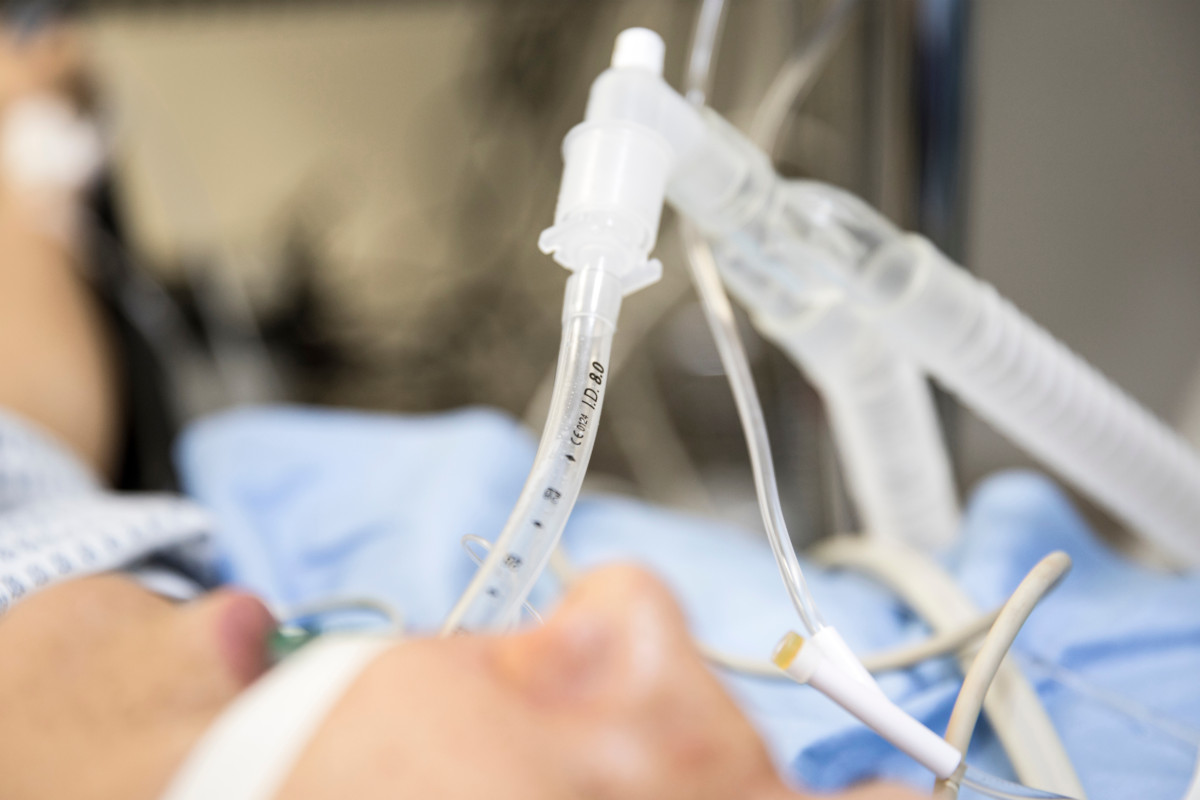
Intubation
BOUGIE Trial
To support seriously ill patients with a breathing machine, doctors must place a breathing tube. One-in-five times doctors cannot place the breathing tube on the first try. When the breathing tube cannot be placed on the first try, the risks to the patient for low oxygen levels or blood pressure are higher. Doctors use two…
CHECK-Up Trial: Up
For patients being placed on a breathing machine, a breathing tube must be placed in the mouth. During placement of a breathing tube, low oxygen levels may occur. Whether placing a breathing tube while the patient’s head and shoulders were elevated (“ramped position”) could prevent low oxygen levels compared to placement of a breathing tube…
PreVent Trial
Low oxygen level is the most common complication that arises when a critically ill patient is being placed on a breathing machine. Whether providing oxygen and ventilation with a bag-mask device prior to placement of a breathing tube prevents low oxygen levels had been unknown. Among 401 patients in 7 intensive care units, the PreVent…
PREPAREII Trial
Patients in the intensive care unit who require treatment with a breathing machine may develop serious problems with blood pressure or heart rhythm while the breathing tube is being placed. To learn whether problems with blood pressure or heart rhythms could be prevented by giving patients fluid through an IV, we led a research study…
FELLOW Trial: VL/DL
To support seriously ill patients with a breathing machine, doctors must place a breathing tube. One-in-five times doctors cannot place the breathing tube on the first try. When the breathing tube cannot be placed on the first try, the risks to the patient for low oxygen levels or blood pressure are higher. Two types of…
FELLOW Trial: AO
Low oxygen levels is the most common complication that arises when a critically ill patient is being placed on a breathing machine. Whether providing oxygen with a small tube below the nose (“nasal cannula”) during the placement of a breathing tube prevents low oxygen levels had been unknown. Among 150 patients receiving a breathing tube…
Proper Trial
When a patient requiring a breathing machine is ready to be disconnected from that machine, providing additional oxygen support using a mask over the patient’s mouth (called “non-invasive ventilation”) or a large tube under their nose (called “high flow nasal cannula”) had been reported to decrease the likelihood of the patient needing to be put…
ETTS
For patients on a breathing machine, doctors may secure the breathing tube in place using either adhesive tape or an endotracheal tube fastener. The ETTS Trial compared the securement technique of adhesive tape versus an endotracheal tube fastener for patients in the medical intensive care unit expected to require a breathing machine for more than…
PREPARE Trial
Patients in the intensive care unit who require treatment with a breathing machine may develop serious problems with blood pressure or heart rhythm while the breathing tube is being placed. To learn whether problems with blood pressure or heart rhythms could be prevented by giving patients fluid through an IV, we led a research study…
DEVICE
What we need to learn When a patient needs a breathing machine, a breathing tube is placed through the mouth and into the windpipe. Difficulty placing the breathing tube may cause serious problems with low oxygen levels, low blood pressure, or injury to the windpipe or lungs. To place the breathing tube, doctors use a…
PREOXI
Clinicians perform rapid sequence induction, laryngoscopy, and tracheal intubation for more than 5 million critically ill adults as a part of clinical care each year in the United States. One-in-ten emergency tracheal intubations is complicated by life-threatening hypoxemia. Administering supplemental oxygen prior to induction and intubation (“preoxygenation”) decreases the risk of life-threatening hypoxemia. In current clinical practice, the most common methods for preoxygenation are non-invasive positive pressure ventilation and facemask oxygen. Prior trials comparing non-invasive positive pressure ventilation and facemask oxygen for preoxygenation have been small and have yielded conflicting results. A better understanding of the comparative effectiveness of these two common, standard-of-care approaches to preoxygenation could improve the care clinicians deliver and patient outcomes.

Non-invasive respiratory support
ICU Survivor Clinic Trial
People who survive critical illness frequently suffer from problems with their strength, thinking, and mental health for months after returning home from the hospital. To test whether a structured program with specific follow-up visits and resources could prevent the need to be readmitted to the hospital for patients who had previously been treated for critical…
CHECK-Up Trial: Checklist
For patients being placed on a breathing machine, a breathing tube must be placed in the mouth. During placement of a breathing tube, low oxygen levels and low blood pressure may occur. Whether using a checklist prior to placing a breathing tube helps prevent these complications is unknown. Among 262 patients being placed on a…
Proper Trial
When a patient requiring a breathing machine is ready to be disconnected from that machine, providing additional oxygen support using a mask over the patient’s mouth (called “non-invasive ventilation”) or a large tube under their nose (called “high flow nasal cannula”) had been reported to decrease the likelihood of the patient needing to be put…
PREOXI
Clinicians perform rapid sequence induction, laryngoscopy, and tracheal intubation for more than 5 million critically ill adults as a part of clinical care each year in the United States. One-in-ten emergency tracheal intubations is complicated by life-threatening hypoxemia. Administering supplemental oxygen prior to induction and intubation (“preoxygenation”) decreases the risk of life-threatening hypoxemia. In current clinical practice, the most common methods for preoxygenation are non-invasive positive pressure ventilation and facemask oxygen. Prior trials comparing non-invasive positive pressure ventilation and facemask oxygen for preoxygenation have been small and have yielded conflicting results. A better understanding of the comparative effectiveness of these two common, standard-of-care approaches to preoxygenation could improve the care clinicians deliver and patient outcomes.

Fluid Management
BALANCE Trial
Patients being treated for sepsis, a serious infection that can lower blood pressure, are often treated with fluids through an IV. Previous studies have shown that a positive fluid balance, or more fluids taken in than out, may be connected to problems with kidney and lung function. The BALANCE pilot trial enrolled 30 patients; 15…
PREPAREII Trial
Patients in the intensive care unit who require treatment with a breathing machine may develop serious problems with blood pressure or heart rhythm while the breathing tube is being placed. To learn whether problems with blood pressure or heart rhythms could be prevented by giving patients fluid through an IV, we led a research study…
SMART Trial
Patients in the intensive care unit frequently receive IV fluid. For more than 100 years, two basic types of IV fluid have been available: saline (which contains more chloride than human blood) and balanced crystalloids (which contains about the same amount of chloride as human blood). No large trials had previously evaluated which fluid resulted…
SALT-ED Trial
Patients in the emergency department are frequently given fluids through an IV as a treatment for a wide variety of injuries and medical complications. Historically, the most common fluid given to patients had been saline. Saline contains a higher concentration of chloride than that of human blood, which could have negative effects on patients’ kidneys…
SALT Trial
Patients in the intensive care unit frequently receive IV fluid. Two basic types of IV fluid exist: saline (which contains more chloride than human blood) and balanced crystalloids (which contains about the same amount of chloride as human blood). No large trials had previously evaluated which fluid resulted in the best outcomes for patients. In…

Systems Based Practice
ICU Survivor Clinic Trial
People who survive critical illness frequently suffer from problems with their strength, thinking, and mental health for months after returning home from the hospital. To test whether a structured program with specific follow-up visits and resources could prevent the need to be readmitted to the hospital for patients who had previously been treated for critical…

Antibiotics
ACORN Trial
Patients in the emergency department and intensive care unit who are suspected of having infections are treated with antibiotics. Most patients received either cefepime or piperacillin-tazobactam, antibiotics targeting resistant gram-negative bacteria. The two antibiotics are believed to have different risks. Cefepime may cause “neurotoxicity” (symptoms like agitation or coma). Piperacillin-tazobactam may cause kidney injury. To…

Mechanical Ventilation
PILOT Trial
Many patients in the intensive care unit (ICU) receive oxygen through a breathingmachine. Doctors, nurses, and respiratory therapist adjust the amount of oxygen giventhrough the breathing machine to target oxygen levels, but the ideal oxygen level to targetis unknown. To understand which oxygen level is best for patients, we conducted aresearch study called the PILOT…
PREOXI
Clinicians perform rapid sequence induction, laryngoscopy, and tracheal intubation for more than 5 million critically ill adults as a part of clinical care each year in the United States. One-in-ten emergency tracheal intubations is complicated by life-threatening hypoxemia. Administering supplemental oxygen prior to induction and intubation (“preoxygenation”) decreases the risk of life-threatening hypoxemia. In current clinical practice, the most common methods for preoxygenation are non-invasive positive pressure ventilation and facemask oxygen. Prior trials comparing non-invasive positive pressure ventilation and facemask oxygen for preoxygenation have been small and have yielded conflicting results. A better understanding of the comparative effectiveness of these two common, standard-of-care approaches to preoxygenation could improve the care clinicians deliver and patient outcomes.

